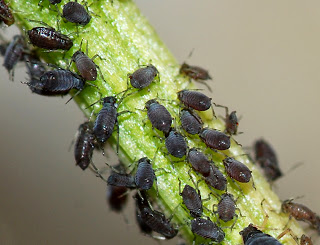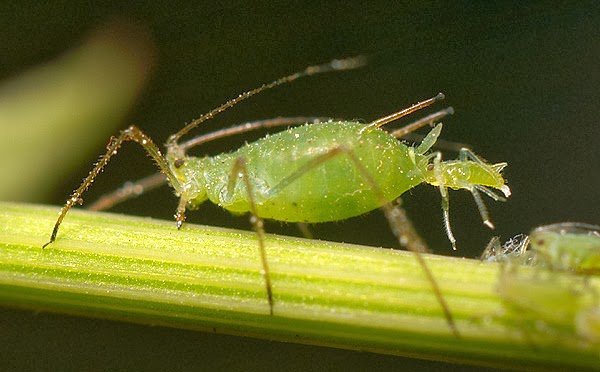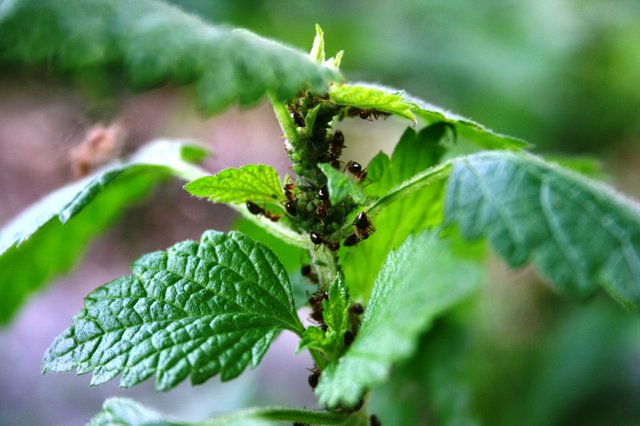Balkan Ecology Project - Aphid Life Cycle
Aphids, an Introduction
The aphids are probably best known as "greenfly", "blackfly" and "white fly". They belong to a group of insects known as "bugs" or Hemiptera, the mouth parts of which are modified to form piercing and sucking tubes. The insects obtain their food by sucking plant juices or the blood of other animals. This group of insects has an incomplete metamorphosis, there being no pupal stage but a series of molts in which the nymph gradually becomes a mature adult.

There are over 4000 species and varieties of aphids but the account given below applies in general to those commonly encountered as garden and orchard pests.
Life history. In October the females lay eggs usually on the stems of trees or shrubs. The eggs are black, with thick shells and can withstand extremes of temperature. It is in the egg form only that aphids pass the winter. In March the eggs hatch out into wingless female nymphs which are similar to the adults, with three pairs of legs, compound eyes, antennae, etc. There is no larval or pupal stage comparable to those of the butterfly, but with successive moults and continuous growth the nymphs become mature females. No males are hatched at all.
The female nymphs feed on the shoots and leaves of the tree on which they hatch, at the time when the buds are sprouting. After a series of molts they become mature and give birth to daughter aphids without any fertilization. This kind of reproduction is called parthenogenesis. The daughters, moreover, are not produced from eggs but are born alive as nymphs though they are surrounded at first by a transparent capsule like an egg membrane.

The daughters grow quickly and themselves have offspring by parthenogenesis. Some of these develop wings which grow larger at each molt. These winged daughters fly off to herbaceous plants such as a rose or bean plant. The aphids are not strong flyers but tend to be carried by chance air currents rather than make direct flights.
When the winged generation reach the new food plant they give birth to wingless daughters parthenogenetically. In warm weather these may mature in 8 to 10 days and begin to reproduce in the same way by bearing winged daughters which fly off and infest new plants. This process of parthenogenesis goes on all through the summer months, winged and wingless generations more or less alternating. Enormous numbers of aphids are produced in this way, though a great many are killed by birds, ladybirds and their larvae, lace-wing larvae, heavy rains and cold weather.
In October the first males appear. They have wings, and fly to a tree. Winged females fly to the same tree and there give birth to wingless daughters. The males mate with these when mature, and the wingless females subsequently lay eggs on the twigs of the tree. The eggs remain dormant until the following spring when the tree buds begin to sprout.
Feeding habits. An aphid feeds by inserting its proboscis, stylet or straw-like mouthpart into the phloem or inner cells of a plant.

Upon insertion the aphid draws the plant’s juices or sap. This feeding activity will normally cause leaf and stem deformities and it can aid the transmission of various plant diseases, both bacterial and viral, all of which can affect the plant's health. An additional problem that may also affect the aesthetics of the plant include presence of cast skins — a by-product of aphids molting from one nymphal stage to the next (which is occasionally confused by novices as stationary whiteflies since they’re white).
Most aphids seem to take in from the plant sap more sugar than they can assimilate and excrete a sweet syrup, honey dew, that is passed out of the anus. Some species of ant like to feed on this exudation and may be seen clambering over the colonies of aphids on nettles and other plants to collect it. If the aphid population grows large enough to support ants it can make organic aphid control even more challenging as the ants defend the aphids from natural predators.
